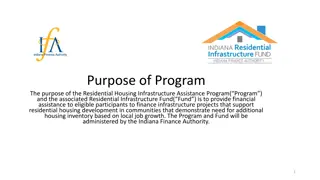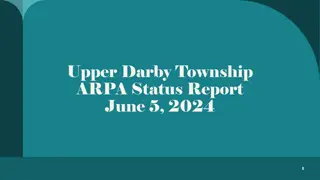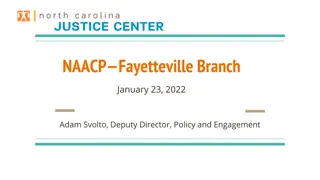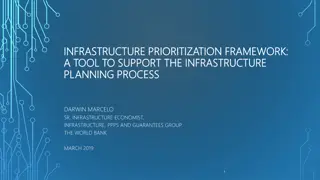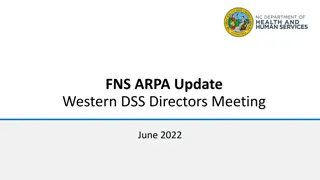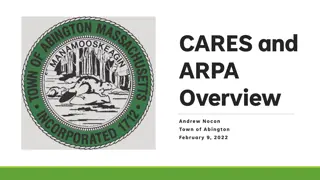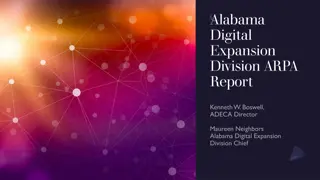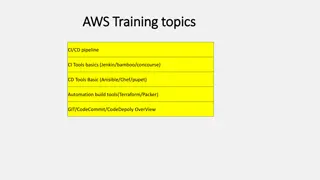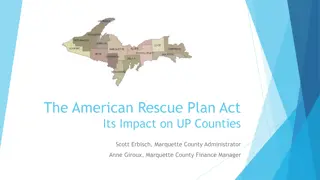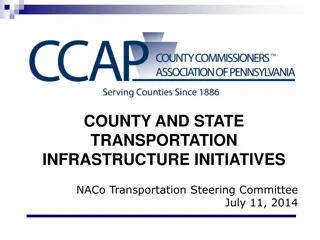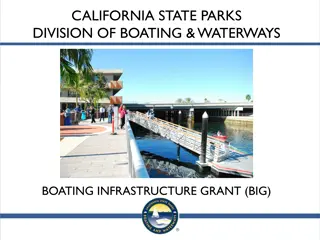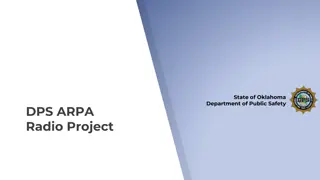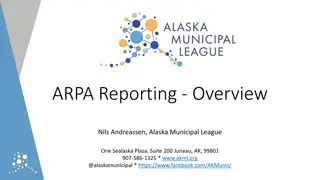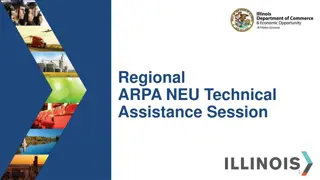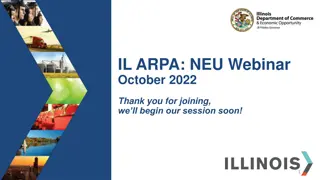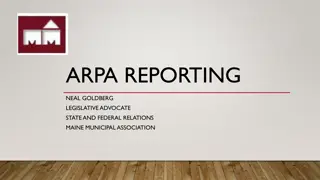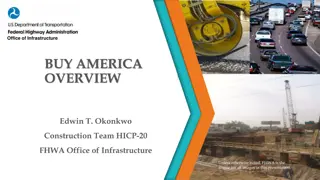Advanced Research Projects Agency Infrastructure (ARPA-I) Overview
ARPA-I, a branch of the U.S. Department of Transportation, focuses on developing innovative infrastructure technologies for transportation, aiming to achieve net-zero emissions and enhance safety, efficiency, and resilience. Topics of interest include materials, digital infrastructure, automated vehicles, and enabling technologies for a modern and sustainable transportation system.
Download Presentation

Please find below an Image/Link to download the presentation.
The content on the website is provided AS IS for your information and personal use only. It may not be sold, licensed, or shared on other websites without obtaining consent from the author.If you encounter any issues during the download, it is possible that the publisher has removed the file from their server.
You are allowed to download the files provided on this website for personal or commercial use, subject to the condition that they are used lawfully. All files are the property of their respective owners.
The content on the website is provided AS IS for your information and personal use only. It may not be sold, licensed, or shared on other websites without obtaining consent from the author.
E N D
Presentation Transcript
Advanced Research Projects Agency Advanced Research Projects Agency Infrastructure (ARPA Infrastructure (ARPA- -I) I) August 2023 Dr. Chris Atkinson Fellow ASME, Fellow SAE Deputy Director for Technology with Dr. Robert Hampshire, Ben Levine, Tony Choi & Patrick Sabol 1
Advanced Research Projects Agency - Infrastructure (ARPA-I) ARPA-I s mission is to catalyze the development of innovative technologies, systems, and capabilities that transform the nation s physical and digital infrastructure to ensure American leadership. We aim to build the future of transportation that is safe, secure, efficient and resilient, while achieving net-zero emissions and increasing equity and access for all. https://www.transportation.gov/arpa-i
The Goal of ARPA-I Develop Innovative Infrastructure Technologies and Solutions for Transportation ARPA-I will be to Transportation as DARPA is to Defense, and ARPA-E is to Energy Develop innovative solutions to persistent problems in infrastructure and transportation Unleash US innovation and creating new infrastructure R&D ecosystems Ensure the US has a 21st Century Infrastructure System and will reach the goal of net-zero GHG emissions by 2050 Develop infrastructure that will create the safest, most efficient, climate friendly and resilient transportation system in the world U.S. Department of Transportation ARPA-I 3
Topics of Interest for ARPA Topics of Interest for ARPA- -I I Advancing DOT priority goals: Safety, Climate, Transformation, and Equity Materials, Structures, and Construction Zero or negative carbon materials for infrastructure, extremely durable and resilient concrete, accelerated construction processes (3D printing of pavement, bridges, tunnels, pipelines, water infrastructure, and high- speed rail beds), accelerated construction of seawalls and shoreline reinforcement Digital Infrastructure for Mobility 6G and edge computing for automated vehicles (AVs), intrinsically assured AI and ML for AVs, virtual LIDAR and ubiquitous machine vision, digital twins, HD mapping of infrastructure and topology (above and below) Automated Surface, Air, and Maritime Vehicles AV development, testing and validation, vehicle connectivity and networking (V2X), freight and logistics automation, fully electrified transportation in-situ charging, V2G AI-enhanced ATC and ATM, assuring safety for autonomous aircraft, infrastructure modifications for AAM integration; autonomous shipping Cross-cutting and Enabling Technologies Advanced PNT millimetric accuracy (including signals of opportunity), cybersecurity (once and for all) intrinsically secure networking and data transmission for mobility infrastructure, digital twins of transportation systems and infrastructure, AR and VR for travel replacement 4
Workshop Agenda Workshop Agenda 15 minutes Overview of the ARPA Model 15 minutes Introduction to ARPA-I Program Design 25 minutes Discussion: Biggest Problems Facing Transportation Infrastructure 20 minutes Discussion: Critical Research Topics Too Early Stage, Foundational, or Big 5
Overview of the ARPA Model Overview of the ARPA Model 6
ARPA ARPA- -I Portfolio I Portfolio An ARPA conducts a rolling portfolio of finite-duration programs If ARPA-I is large enough, the focus areas can become one level of management (e.g., offices at DARPA) ARPA-I Mission Focus area 2 Focus area N Focus area 1 Each program will have a start and an end date typically 3-5 years Program 1Z Program 2Z Program 1A Program 2A Program 1B Program 2B Program NZ Program NA Program NB Program Directors will follow a similar timeline as the programs they oversee Adopt/scale Adopt/scale Adopt/scale Adopt/scale Adopt/scale Adopt/scale Adopt/scale Adopt/scale Adopt/scale Full adoption and scale happen outside of ARPA-I but need to be considered all along 7
ARPA ARPA- -I Project Lifecycle I Project Lifecycle There are various scenarios of an ARPA-I project lifecycle from funding (Stage 1) to commercialization (Stage 2) to deployment (Stage 3) Stage 1 (ARPA-I Project) Stage 2 (Tech to Market) Stage 3 (Tech to Deployment) Stage 1 Pivot Stage 1 Stage 1 Stage 2 Stage 1 Stage 1B (OAs*, others) Stage 2 Stage 3 Stage 1 Stage 2 (VC**, PE***, others) Stage 3 *Operating Administrations **Venture Capital ***Private Equity 8
What Makes an ARPAs Structure Unique? What Makes an ARPA s Structure Unique? In an ARPA Program Directors set the technical direction and are key to the success of each program There is a continuous and structured emphasis on tech to market transitions There are frequent staff transitions and Science and Engineering Technical Assistants (SETAs) are depended on for continuity Scaling is built into the infrastructure of the agency 9
What Makes an ARPAs Culture Unique? What Makes an ARPA s Culture Unique? In an ARPA Taking risks is not only encouraged, but required for the agency s success Team members must adopt an entrepreneurial mindset in their work Collegiality must be woven into the agency s fabric The agency s focus and exploration areas should remain above the political fray Outcomes are far more important than adhering to a strict process - there is no roadmap 10
What does success look like for an ARPA? What does success look like for an ARPA? 11
Infrastructure Technology R&D at USDOT Infrastructure Technology R&D at USDOT ARPA-I fills a gap in innovative early-stage research across transportation modes Advanced Research Deployment Program Focus Aviation Roadway Transit Rail Pipeline Maritime 12
Introduction to ARPA Introduction to ARPA- -I Program Design Design I Program 13
Recent ARPA Recent ARPA- -I Request for Information I Request for Information Potential Research and Development Areas of Interest for ARPA-I Priority focus areas for consideration are: Safety Advanced Construction Materials and Methods Digital Infrastructure Freight and Logistics Optimization Climate and Resilience Other Areas in Transportation Infrastructure 14
How the ARPA Model Manifests How the ARPA Model Manifests R&D Program Design Wireframes Problem A specific pivotal problem + clear diagnosis Future What becomes possible if the program is successful and fully implemented Program objective A bold goal for the future Opportunity Promising methods, approaches, or technologies 15
Moving Through Wireframe Stages Moving Through Wireframe Stages Opportunity Program Objective Future Problem Employ root cause analysis to articulate clear problems and obstacles to the realization of ideal future states in transportation infrastructure, and design with problems in mind before solutions to ensure targeted impact. Surface and prioritize opportunities that are relevant to solving specific problems, with consideration for whether ARPA-I can or should play a role in advancing an opportunity based on where it sits on the development spectrum. Draft a comprehensive advanced research program objective and plan, which would include clear 3-5 year timelines, milestones, activities, and necessary collaborations across the transportation infrastructure ecosystem. Envision a future state that would be transformational for society and across sectors if it were to be realized, with an eye toward impact for everyday end users and customers. 16
Begin with the Problem Begin with the Problem Before applying technology solutions, we must determine fundamental problems that are well-suited for ARPA-I to solve by asking ourselves Is this a problem that involves the development of new technologies, systems, or capabilities for solving persistent problems in infrastructure (both physical and digital)? Does solving the problem require collaboration across disciplines or transportation modes? Does the problem require ideas that researchers aren't even contemplating because they wouldn't normally be funded? Does the problem seem insurmountable by individual actors or organizations? In other words, can anyone else realistically solve it? Does solving the problem require a number of different approaches that can be run in parallel? Does solving this problem allow for further development, commercialization, and ultimately deployment by other entities? 17
Discussion Discussion 18
For Discussion For Discussion What are the biggest problems currently facing transportation infrastructure? Think in particular of problems that cross multiple modes and for which we require solutions on a 10-year timeline What will the biggest problems be over the next 30 years? Problems, not solutions Problems, not solutions 19
For Discussion For Discussion What critical research topics underpinning the RD&T Grand Challenges are important but currently too early stage, too foundational, or too big? Problems, not solutions Problems, not solutions 20
Thank You! Dr. Chris Atkinson Dr. Chris Atkinson Deputy Director of Technology (ARPA Deputy Director of Technology (ARPA- -I) I) Office of the Secretary for Research and Technology (OST-R) chris.atkinson.ctr@dot.gov with Dr. Robert Hampshire, Ben Levine, Tony Choi & Patrick Sabol U.S. Department of Transportation 21




